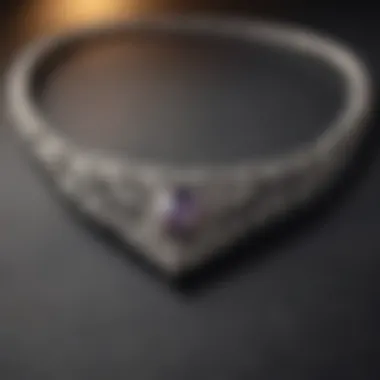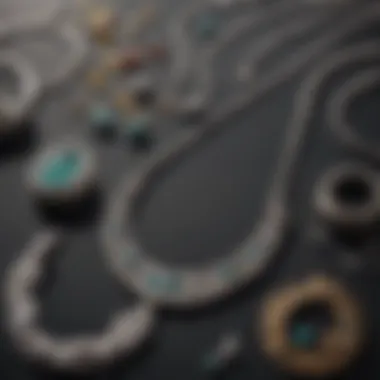Expert Tips for Cleaning Tarnished Silver Necklaces with Ease


Overview of Cleaning Tarnished Silver Necks
When delving into the realm of silver necklace care, one cannot ignore the pervasive issue of tarnish. The process of effectively cleaning tarnished silver necklaces is an art that every jewelry enthusiast needs to master. It serves not only as a means of restoring the jewelry's original allure but also as a way to prolong its lifespan. In this comprehensive guide, we will unravel the mysteries of silver tarnish and explore the various methods and techniques to restore your silver necklaces to their former glory.
Introduction
Understanding Tarnish
What Causes Tarnish on Silver Necklaces?
Exploring the root causes of tarnish on silver necklaces unveils the impact of various environmental factors on the jewelry's surface. Oxidation, a common culprit, forms a layer of tarnish that diminishes the necklace's shine. Understanding this phenomenon is crucial for comprehending why silver tarnishes and how to address it effectively. By grasping the chemical reactions involved, individuals can tailor their cleaning approaches to combat tarnish successfully.
Impact of Environment on Tarnishing
The environment plays a substantial role in the tarnishing process of silver necklaces. Elements like sulfur in the air and exposure to moisture can accelerate tarnish formation, underscoring the need for proactive measures to mitigate these effects. Recognizing how environmental conditions contribute to tarnishing empowers individuals to adopt protective strategies that preserve the pristine condition of their silver jewelry.
Preventive Measures
Storing Silver Necklaces Properly


Proper storage of silver necklaces is fundamental in preventing tarnish buildup. Utilizing anti-tarnish pouches or containers helps shield the jewelry from moisture and air, mitigating the risk of tarnishing. Implementing adequate storage practices ensures that silver necklaces retain their brilliance for extended periods, reducing the frequency of intensive cleaning.
Avoiding Exposure to Harsh Chemicals
Protecting silver necklaces from exposure to harsh chemicals is imperative for maintaining their integrity. Chemical substances in cleaning agents or cosmetics can accelerate tarnish formation, necessitating vigilance in product usage. By steering clear of harsh chemicals, individuals safeguard the luster and quality of their silver jewelry.
Materials Needed
Gentle Soap
Gentle soap serves as a mild yet effective cleaning agent for silver necklaces. Its non-abrasive nature ensures thorough cleansing without causing damage to the metal, making it an ideal choice for delicate jewelry pieces. Incorporating gentle soap into the cleaning regimen guarantees safe and gentle removal of tarnish, restoring the necklace's radiant appearance.
Soft Cloth
A soft cloth is indispensable for buffing and polishing silver necklaces to a brilliant shine. Its gentle texture prevents scratching or abrasions on the metal surface, preserving the necklace's smooth finish. Utilizing a soft cloth enhances the overall cleaning process, ensuring the optimal restoration of the necklace's luster.
Silver Polish
Silver polish serves as a specialized solution to enhance the shine and brightness of silver necklaces. With its ability to target tarnish and restore metallic luster, silver polish is a valuable tool in revitalizing tarnished jewelry. Incorporating silver polish into the cleaning routine ensures professional-grade results, elevating the beauty of silver necklaces.


Methods for Cleaning
Using Soapy Water
Soapy water offers a simple yet effective method for removing tarnish from silver necklaces. By creating a gentle cleaning solution with soap and water, individuals can delicately cleanse the jewelry without causing damage. The mild yet potent nature of soapy water makes it a versatile and accessible option for restoring the sparkle to tarnished silver necklaces.
Polishing with Silver Cloth
Polishing silver necklaces with a silver cloth is a meticulous technique that yields impressive results. The specialized fabric of the silver cloth allows for precise buffing and polishing, effectively reducing tarnish buildup and enhancing the necklace's sheen. Incorporating silver cloth polishing into the cleaning regimen ensures thorough cleaning and impeccable results.
DIY Baking Soda Paste
Crafting a DIY baking soda paste presents a cost-effective and efficient method for cleaning tarnished silver necklaces. The abrasive yet gentle nature of baking soda aids in scrubbing away tarnish, revealing the jewelry's original brilliance. Developing a baking soda paste offers a customizable and gratifying cleaning solution for individuals seeking a hands-on approach to jewelry care.
Step-by-Step Cleaning Guide
Inspecting the Necklace
Thoroughly inspecting the necklace for tarnish spots and discoloration is the initial step in the cleaning process. Identifying areas of tarnish helps determine the appropriate cleaning method and products to use, ensuring tailored care for the necklace. By scrutinizing the necklace closely, individuals can address tarnish effectively and restore its luminous quality.


Applying the Cleaning Solution
Applying the chosen cleaning solution or paste to the tarnished areas requires precision and care. Ensuring even coverage and gentle application avoids potential scratches or damage to the necklace's surface. By methodically applying the cleaning solution, individuals target tarnish effectively and initiate the restoration process with finesse.
Polishing and Buffing
Polishing and buffing the necklace post-cleaning enhances its visual appeal and reflective quality. Using a soft cloth or specialized polishing tool, individuals gently buff the metal to achieve a dazzling shine. The meticulous polishing and buffing actions elevate the necklace's overall aesthetics, culminating in a revitalized and radiant piece of jewelry.
Special Considerations
Cleaning Intricate Designs
Navigating the cleaning process for intricate necklace designs requires attention to detail and careful handling. Complex patterns or intricate structures may harbor hidden tarnish, necessitating thorough cleaning methods. By strategizing cleaning approaches for intricate designs, individuals ensure that every crevice and detail receives proper care, preserving the necklace's intricate beauty.
Dealing with Stubborn Tarnish
Addressing stubborn tarnish spots demands patience and targeted cleaning methods. Persistent tarnish may require repeated treatments or specialized solutions to dissolve and remove effectively. By employing strategic techniques and persistence, individuals can conquer stubborn tarnish and restore the necklace to its former glory.
Final Tips
Regular Maintenance
Maintaining regular cleaning and care routines is instrumental in preserving the integrity of silver necklaces. By incorporating consistent maintenance practices, individuals can prevent extensive tarnish buildup and maintain the necklace's shine over time. Regular upkeep ensures that silver necklaces retain their allure and quality for generations to come.
Professional Cleaning Services
Opting for professional cleaning services offers a comprehensive and meticulous solution for rejuvenating silver necklaces. Experienced professionals utilize advanced techniques and products to deliver unparalleled results, ensuring thorough tarnish removal and expert-level polish. Seeking professional cleaning services periodically provides a thorough and refined treatment for silver necklaces, enhancing their longevity and attractiveness.







